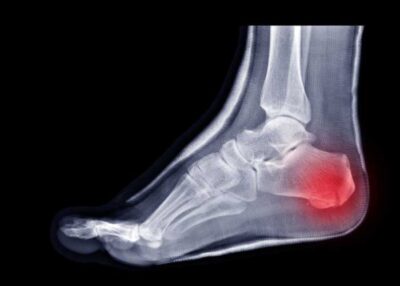Broken Heel Specialists
Are you an athlete who participates in skiing, snowboarding, or other high-energy sports? If so, you may be at an increased risk of sustaining a calcaneal fracture. Also called a broken or fractured heel, calcaneal fractures can cause constant, consistent pain, swelling and the inability to walk. Foot and ankle specialists, Doctors Thomas Haytmanek and Jonathon Backus have diagnosed and treated many patients in Vail, Aspen, and the surrounding Denver, Colorado communities who have experienced a heel fracture. If you believe you may have injured your heel, contact The Steadman Clinic’s Sports Foot and Ankle team today!

What is a Calcaneal Fracture?
A calcaneal fracture is an injury when the bone of the heel sustains a crack or a break due to a high energy impact such as a fall while skiing or snowboarding or a car accident. A calcaneal fracture can also be caused by stress fractures or repetitive stress over time. The outside of the heel bone is made of very hard, dense (cortical)bone while the inside is made of softer bone. A broken heel bone, or calcaneal fracture, frequently involves movement of the fracture fragments and injury to the subtalar joint, which may lead to arthritis. The Steadman Clinic’s Sports Foot and Ankle specialists have extensive successful experience treating individuals from Vail, Colorado and the surrounding Eagle and Vail Mountain ranges who have suffered a calcaneal fracture.

What are the Symptoms of a Calcaneal Fracture?
The symptoms of a calcaneal fracture differ from another type of heel injury called plantar fasciitis, which involves inflammation of the surrounding tissue, not damage to bone. Plantar fasciitis usually causes pain in the morning and gradually decreases throughout the day. A break in the heel bone, or a calcaneal fracture causes the following symptoms:
- Consistent Pain
- Swelling
- Bruising in the heel and surrounding area
- Sudden sharp pain if caused by trauma
- Heel deformity
- Inability to bear weight on the affected foot
How is a Calcaneal Fracture Diagnosed?
The specialists at The Steadman Clinic’s Sports Foot and Ankle will perform a physical examination of the broken heel bone. They will order x-rays to gain a better idea of the severity of the fracture and may require an MRI or CT scan to determine the exact fracture pattern. The MRI and CT scan can also help identify other injuries such as tendon or ligament injuries.
What is the Treatment for a Calcaneal Fracture or a heel bone fracture?
Non-Surgical Treatment:
Treatment for a broken heel bone or calcaneal fracture is dependent upon the amount of displacement of the fracture and if other injures were also sustained. Surgery may not be necessary if your fracture has not displaced the bone and if remains in its correct anatomical position. If your doctor suggests a cast or boot instead of surgery, you may need crutches to avoid bearing weight on the injured foot. Physical therapy will also be required to gain strength and mobility. It could take up to six months to heal from this type of break.
Surgical Treatment:
If the severity of the break requires surgery, Dr. Haytmanek or Dr. Backus may wait until the swelling has subsided to perform the operation. In the event the bone has punctured the skin, immediate surgery is required to correct it. It will depend on the type of fracture your heel has incurred to determine if special screws or metal plates will be necessary. These will help hold the bones in place while they heal. If surgery is required, there is usually a 6 week period of non-weight bearing afterward. A course of physical therapy will be needed to improve subtalar range of motion and regain strength after the injury and surgery.
For more information on calcaneal fractures and the treatment options available, please contact The Steadman Clinic’s Sports Foot and Ankle Specialists serving Vail, Colorado, and the surrounding Eagle, Vail Mountain Ranges.